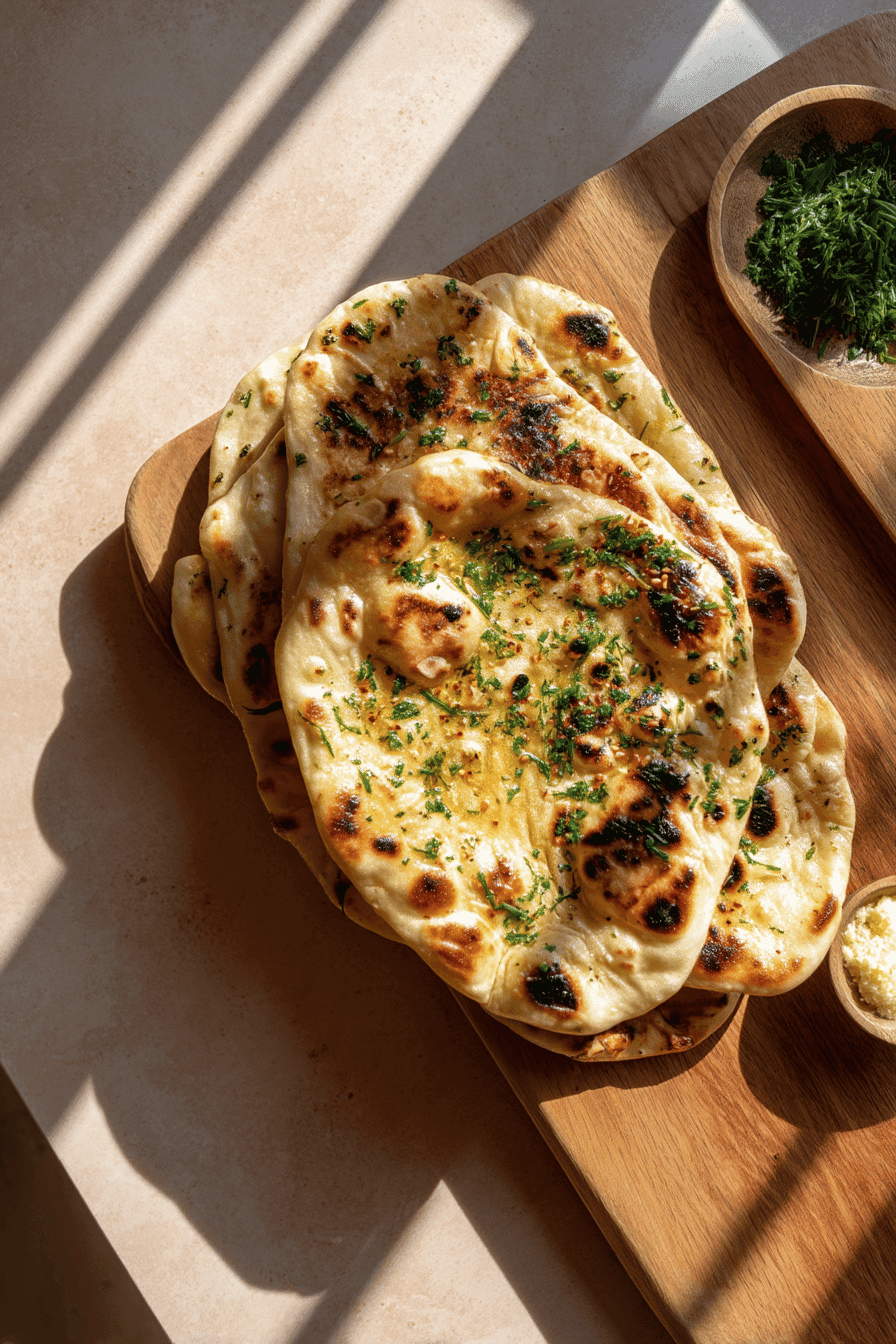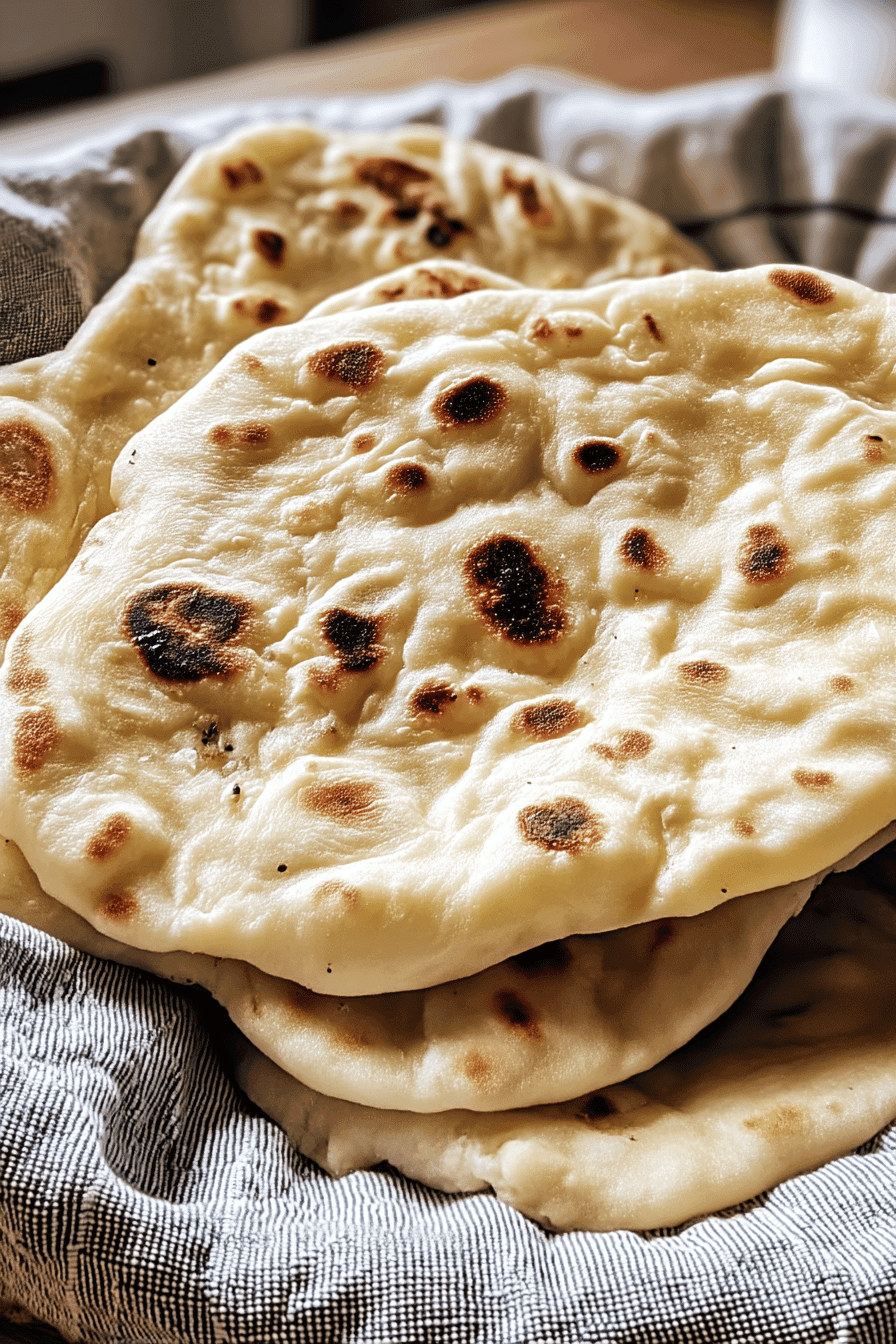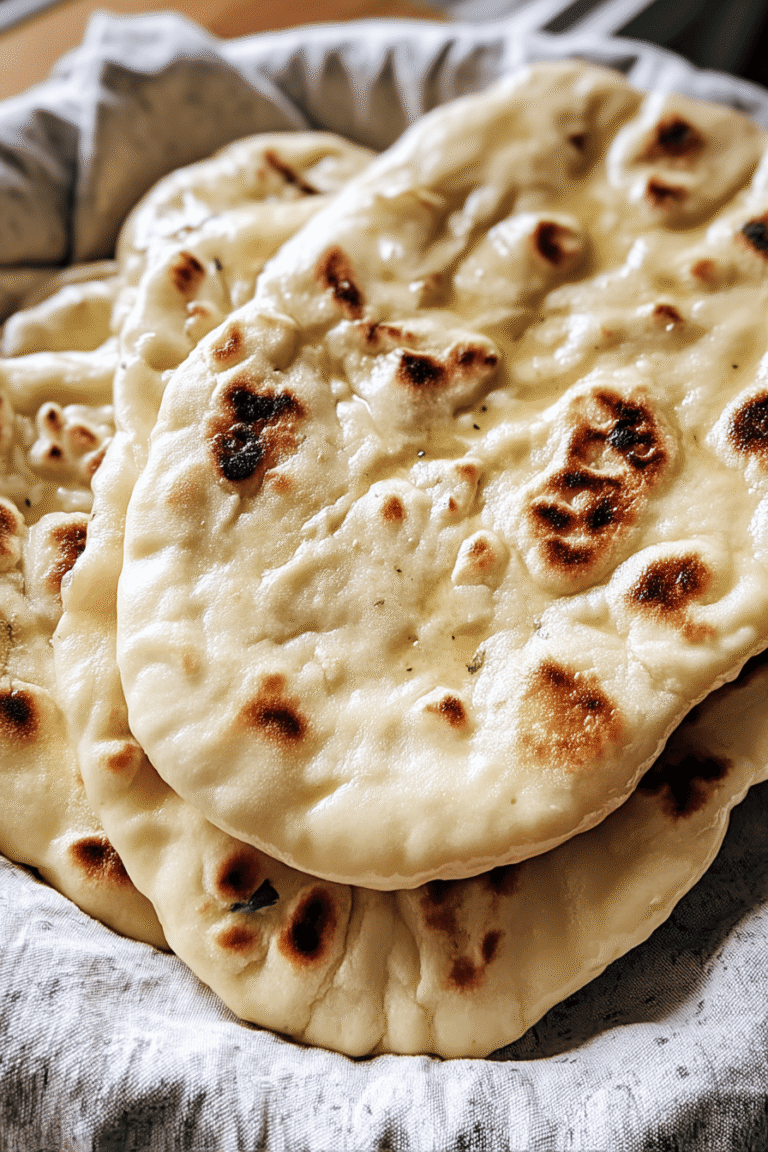Benefits and Advantages of homemade naan bread
Homemade naan bread combines authentic flavor with the convenience of home cooking, offering several notable benefits. Its preparation uses simple, pantry-friendly ingredients, making it accessible for most home cooks. Unlike prepackaged or restaurant-bought naan, homemade versions allow you to control freshness and ingredients, avoiding preservatives. This recipe produces soft, fluffy, and chewy naans much like those served in Indian restaurants, without the need for a tandoor oven. With options to adapt for gluten-free or vegan diets, homemade naan caters to diverse preferences and health considerations. The bread’s versatility means it complements a wide range of dishes from rich curries and grilled meats to fresh salads and dipping sauces making it a practical staple for family meals and gatherings. Additionally, homemade naan is a cost-effective way to enjoy fresh flatbread and can be customized with garlic, herbs, or cheese, enhancing both nutrition and flavor.
Jump to:
- Benefits and Advantages of homemade naan bread
- Essential Ingredients for homemade naan bread
- Dietary Substitutions to Customize Your homemade naan bread
- How to Prepare the Perfect homemade naan bread: Step-by-Step Guide
- Mastering homemade naan bread: Advanced Tips and Variations
- How to Store homemade naan bread: Best Practices
- Nutritional Value of homemade naan bread
- FAQs: Frequently Asked Questions About homemade naan bread
- What ingredients do I need to make homemade naan bread from scratch?
- How do I make naan bread soft and fluffy at home?
- Can I prepare naan dough ahead of time and how should I store it?
- What is the best way to cook naan bread at home without a tandoor oven?
- How should I store and reheat leftover homemade naan bread?
- Simple Recipe for Soft, Chewy, and Fluffy Homemade Naan Bread
- Ingredients
- Instructions
- Last Step:
- Notes
- Nutrition
- Did you make this recipe?
Essential Ingredients for homemade naan bread
- 1 to 2 teaspoons instant or rapid-rise yeast (1 teaspoon for 6 naans, up to 2 teaspoons for 8 naans or freezing)
- 1/2 cup (120 ml) warm water (about 105-115°F / 40-46°C)
- 1 tablespoon white sugar or granulated sugar
- 2 to 3 tablespoons full-fat milk (low-fat milk can also be used)
- 1 large egg or 1 1/2 tablespoons whisked egg (optional for texture variation)
- 1/2 teaspoon cooking or kosher salt
- 1 3/4 to 3 cups bread flour or all-purpose flour (bread flour recommended for chewiness)
- 2 tablespoons ghee or unsalted butter, melted (plus extra for brushing; olive oil or regular butter may be substituted)
- Optional: minced garlic for garlic butter, nigella seeds, chopped fresh coriander/cilantro
- Optional for cheese naan: about 1/4 cup loosely packed shredded melting cheese such as cheddar or Monterey Jack
These ingredients work together to create a flavorful dough that rises properly and yields soft, airy bread with desirable chewiness. Yeast activation with sugar and warm water ensures proper fermentation. Yogurt is not required in this base recipe, avoiding gumminess, but milk and egg contribute tenderness and richness. Bread flour enhances gluten structure for chewiness, while ghee adds depth of flavor and withstands high cooking temperatures well. Optional additions allow for flavor boosts and personalization.

Dietary Substitutions to Customize Your homemade naan bread
Customizing homemade naan bread to suit dietary restrictions or preferences is straightforward through several substitutions:
- Gluten-free: Replace bread or all-purpose flour with a gluten-free bread flour blend designed to mimic gluten’s elasticity. This allows for a similar texture without gluten.
- Vegan: Substitute egg with a flax or chia egg, and use plant-based milk (such as almond or soy milk) in place of dairy milk. Replace butter or ghee with vegan margarine or olive oil.
- Lower fat: Use low-fat or skim milk and reduce or omit butter/ghee in the dough, while brushing the finished naan lightly with oil to maintain flavor.
- No yeast/quick version: Baking powder can replace yeast, yielding faster dough but a slightly less chewy texture.
- Whole wheat: Substitute half or all of the white flour with whole wheat flour for additional fiber and a nuttier flavor, adjusting liquid content as needed.
Each substitution keeps the spirit of homemade naan intact while accommodating your specific dietary goals or ingredient availability.
How to Prepare the Perfect homemade naan bread: Step-by-Step Guide
- Activate yeast: In a small bowl, combine instant yeast, sugar, and warm water (105-115°F). Let stand 5-10 minutes until foamy to confirm yeast is active.
- Mix wet ingredients: Whisk together milk and egg (if using) in a separate bowl.
- Combine dry ingredients: Sift flour and salt into a large mixing bowl, making a well in the center.
- Form dough: Pour yeast mixture, melted ghee/butter, and milk-egg mixture into the well. Stir with a spatula initially, then knead by hand to form a soft, sticky dough. Knead for about 3 minutes if preferred; minimal kneading is sufficient to keep tenderness.
- Let dough rise: Cover the bowl with a clean cloth or plastic wrap and place in a warm spot for 1 to 1.5 hours until the dough doubles in size.
- Divide and shape: Turn dough onto a floured surface, divide into 6-8 equal portions, and roll each into a smooth ball. Rest loosely covered for 15-20 minutes to puff slightly.
- Roll out naans: Roll each ball into a circle about 3 to 5 mm thick and 6 to 6.5 inches wide thickness is key to softness and bubbling.
- Cook naans: Heat a well-seasoned cast iron or heavy skillet over medium-high heat until just smoking. Lightly oil with a paper towel if needed. Cook naans 1 to 1.5 minutes on one side until golden and bubbly, then flip and cook another 1 to 1.5 minutes until golden brown spots appear. Adjust heat as necessary for even cooking without burning.
- Optional cheese naan: After rolling, brush with butter or garlic butter, add 1/4 cup cheese in center, seal edges into bundle, flip smooth side up, roll gently to about 6 mm thick. Cook as above.
- Finish and serve: Brush hot naan with melted ghee, butter, or garlic butter, sprinkle with nigella seeds and fresh herbs if desired. Serve immediately for best texture and flavor.
Following these straightforward steps yields soft, fluffy, and chewy homemade naan bread that pairs beautifully with a variety of dishes and can be customized for special dietary needs.

Mastering homemade naan bread: Advanced Tips and Variations
To create the perfect homemade naan bread, consider a few advanced techniques and creative modifications. For extra softness, substitute half of the water with milk or opt for richer yogurt to enhance tenderness. Experiment with filling the dough with minced garlic, chopped fresh herbs, or grated cheese before cooking to add delightful bursts of flavor. Achieving traditional charred spots is easier by using a very hot cast-iron skillet or cooking over an open flame when possible. For gluten-free doughs, longer resting times improve hydration and texture, making the bread less crumbly and more pliable. Adding spices such as cumin seeds or nigella seeds to the dough brings an aromatic and unique dimension. To achieve a crispier naan, roll the dough thinner and increase cooking time slightly without burning. Another popular variation is brushing the naan post-cooking with garlic butter for a rich and flavorful finish. These tips help you customize naan to your taste while mastering the traditional texture and flavor every time.
How to Store homemade naan bread: Best Practices
Storing your homemade naan bread properly preserves its fresh texture and flavor. For short-term storage, wrap the naan tightly in aluminum foil or place it in an airtight container at room temperature, good for up to two days. For refrigeration, place naan in a sealed plastic bag to prevent drying and keep it fresh for up to a week. When freezing, separate individual naan pieces with parchment paper and store them in a freezer-safe bag for up to two months. To reheat, warm naan in a hot skillet or directly over a gas flame for a few seconds on each side, restoring softness and achieving a slight crispiness. Alternatively, wrap the naan in foil and heat it in a 350°F (175°C) oven for about 10 minutes until warmed through. These storage and reheating methods maintain the bread’s ideal texture and bring out its fresh, homemade flavors whenever enjoyed.
Nutritional Value of homemade naan bread
| Nutrient | Approximate Amount per Naan | Health Benefit |
|---|---|---|
| Calories | 220-230 kcal | Provides moderate energy from balanced macronutrients |
| Carbohydrates | 29-31 g | Primarily from flour, supplying steady energy release |
| Protein | 5 g | Supports tissue repair and maintenance |
| Fat | 8-10 g | Includes saturated and unsaturated fats from butter or ghee |
| Cholesterol | 29-36 mg | Contributes to cellular function and hormone production |
| Sodium | 160-280 mg | Moderate, adjustable by salt content added to dough |
| Fiber | 1 g | Supports healthy digestion |
| Sugar | 1-2 g | Minimal, sourced mainly from sugar to activate yeast |
Using whole wheat or gluten-free flours can alter fiber content and the glycemic index, tailoring naan to dietary needs. The use of ghee offers potential benefits over butter by withstanding high heat better and providing a richer taste. For insights on benefits of using ghee in cooking and tips for perfect yeast dough, explore recommended resources.

FAQs: Frequently Asked Questions About homemade naan bread
What ingredients do I need to make homemade naan bread from scratch?
How do I make naan bread soft and fluffy at home?
Can I prepare naan dough ahead of time and how should I store it?
What is the best way to cook naan bread at home without a tandoor oven?
How should I store and reheat leftover homemade naan bread?

Simple Recipe for Soft, Chewy, and Fluffy Homemade Naan Bread
🍞 Enjoy the authentic taste of soft, chewy, and fluffy naan bread made easily at home without a tandoor oven.
🥘 Perfect for serving alongside curries, using as a wrap, or just enjoying on its own with a touch of garlic butter.
- Total Time: 1.5 to 2 hours
- Yield: 6–8 naan breads 1x
Ingredients
1 to 2 teaspoons instant or rapid-rise yeast
1/2 cup (120 ml) warm water
1 tablespoon white sugar
2 to 3 tablespoons full-fat milk
1 large egg or 1 1/2 tablespoons whisked egg
1/2 teaspoon cooking or kosher salt
1 3/4 to 3 cups bread flour or all-purpose flour
2 tablespoons ghee or unsalted butter, melted
Optional finishing: minced garlic, nigella seeds, chopped fresh coriander/cilantro
For cheese naan option: about 1/4 cup shredded cheese
Instructions
1. Bloom yeast in warm water with sugar, cover and let sit until foamy (5-10 minutes).
2. Whisk milk and egg together in a small bowl.
3. Sift flour and salt into a large bowl. Make a well and add yeast mixture, melted butter, milk-egg mixture. Mix to a sticky dough.
4. Cover and proof in a warm place for 1-1.5 hours until doubled.
5. Divide dough on a floured surface into 6-8 pieces, shape into balls. Rest for 15-20 minutes.
6. Roll each ball into circles about 3-5 mm thick and 6-6.5 inches wide.
7. Heat cast iron or skillet on medium-high. Cook naan 1.5 minutes per side until bubbly and golden.
8. For cheese naan, add cheese before rolling and cook similarly.
9. Brush hot naan with ghee or butter, sprinkle with optional toppings, serve warm.
Last Step:
Please leave a rating and comment letting us know how you liked this recipe! This helps our business to thrive and continue providing free, high-quality recipes for you.Notes
⚖️ Use bread flour for a chewier texture, or all-purpose flour for convenience.
🍃 Adding nigella seeds or fresh herbs enhances flavor authenticity.
🔥 Ghee is preferred for high heat cooking, but butter or olive oil can be used.
- Prep Time: 20-30 minutes
- Dough Rising: 1.5 hours
- Cook Time: 10-25 minutes
- Category: Bread
- Method: Stovetop
- Cuisine: Indian
- Diet: Vegetarian
Nutrition
- Serving Size: 1 naan
- Calories: 220-230
- Sugar: 1-2 g
- Sodium: 160-280 mg
- Fat: 8-10 g
- Saturated Fat: 2-6 g
- Unsaturated Fat: N/A
- Trans Fat: N/A
- Carbohydrates: 29-31 g
- Fiber: 1 g
- Protein: 5 g
- Cholesterol: 29-36 mg







